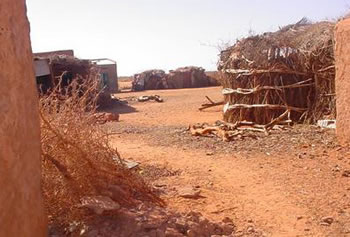 |
© IRIN
Abandoned villages in drought-stricken Somalia
|
NAIROBI, 19 Jan 2006 (IRIN) - At least 1.7 million people in Somalia are in urgent need of humanitarian assistance following the failure of rains in 2005, the Food Security Analysis Unit (FSAU) of the United Nations Food and Agriculture Organization warned on Thursday.
The situation is particularly acute in the southern regions, according to a recent FSAU food security and livelihood survey. Malnutrition rates, the FSAU added, had reached over 25 percent in some areas and were expected to get worse in the coming months.
"Fifteen percent is a humanitarian emergency and we are already at 25 percent," Nick Haan, FSAU chief technical advisor, told reporters in Nairobi.
FSAU estimated that crop production for this year would be 50 percent of the post-war average - the lowest cereal production in over 10 years. Cattle deaths in the worst affected areas had reached 20 to 30 percent and could reach 80 percent by April.
"Currently, we are in a humanitarian emergency. We are one phase away from famine," Haan said. "If it [famine] will happen, it will happen very quickly."
The worst affected areas are Gedo, Lower and Middle Juba, and Bay and Bakool. FSAU warned that there was a "moderate risk of famine" in the Gedo region and surrounding areas before the next expected rainy season in April-June 2006.
UN Somalia resident representative and humanitarian coordinator, Maxwell Gaylard, noted that although the humanitarian agencies had some resources, the scale of the crisis was beyond what the Somali people, the Transitional Federal Government or the aid agencies could cope with.
"We need external assistance," Gaylard said. "It is not a dry season or a drought period, it's a drought," he added.
Christian Balslev-Olesen, the representative of the UN Children's Fund Somalia, warned that the longer a large-scale intervention was delayed, the longer people continued to suffer and the worse the security situation would become.
"It will deteriorate the political situation," he noted. "People will start looting, they will start hijacking and insecurity will get worse very quickly."
He urged the Somali authorities to use the looming crisis as a political opportunity, however, to encourage rival factions to work together to mitigate the suffering.
Gaylard also urged donors to take into account the regional dynamics of the drought, which has also affected northern Kenya and southern Ethiopia. With a regionally coordinated approach, he noted, mass cross-border movements towards areas that were receiving more generous assistance than others could be avoided.
"This crisis easily compares with any other humanitarian crisis going on around the world today," the FSAU's Haan said.
"Early predictions are already forecasting below average rainfall during the Gu [rainy season] in April, May, June," he warned. "This would take the crisis to a whole different level, it doesn't bode well."
Haan said, however, that there was still a window of opportunity "to prevent the starving baby images". Agencies were already responding, he added, but assistance needed to be "ratcheted up" urgently.
"Under normal conditions, Somalia is one of the poorest and most food insecure countries in the world, and these are not normal conditions," Haan added. "It is a humanitarian crisis - it is a food crisis, a water crisis, a health crisis and a protection crisis."
[ENDS]